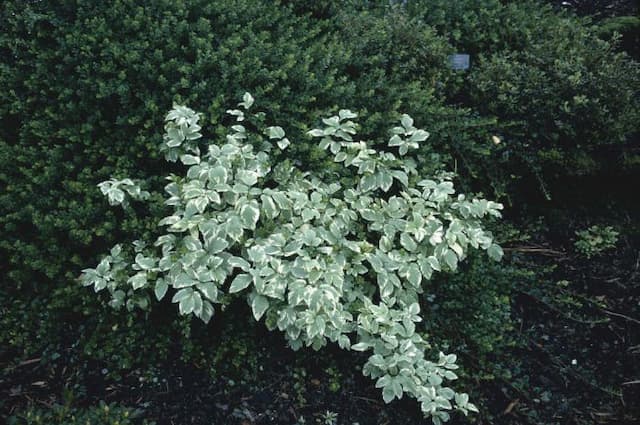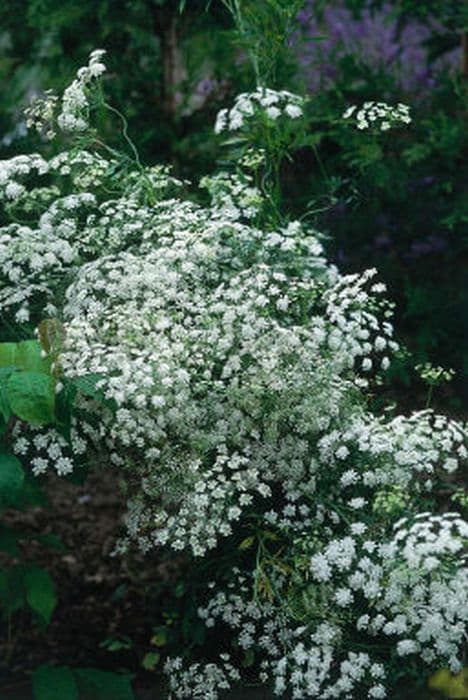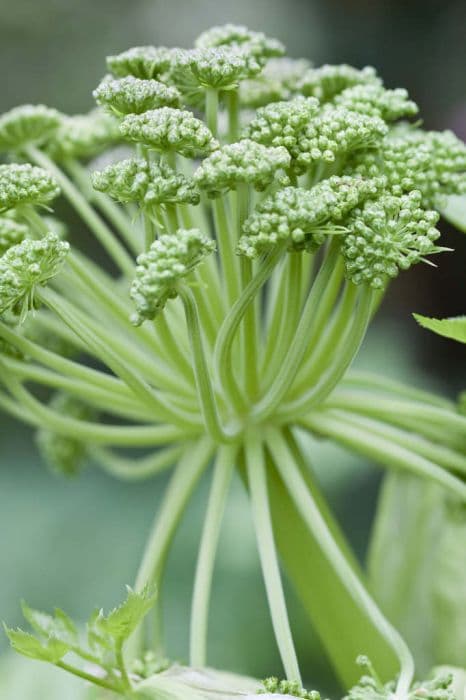Rattlesnake Master Eryngium yuccifolium

ABOUT
Eryngium yuccifolium, commonly known as rattlesnake master, is a perennial plant with a distinctive and striking appearance. The foliage of this plant is similar to that of the yucca, featuring a rosette of long, rigid leaves that are blue-green in color. These leaves possess sharp pointed tips and are often edged with small teeth, contributing to the plant's bold texture. The most striking feature of rattlesnake master is its spherical flower heads, which appear atop stiff, branched stalks. These bloom clusters are dense and bristly, ranging in color from silvery-white to pale green. Each globular head is made up of numerous tiny flowers that are tightly packed together, giving the impression of a pincushion. Despite the removal of size-related descriptions, the plant's overall form is upright and clump-forming, presenting a strong architectural element to the landscape. Its unique look is frequently used as a focal point or as part of mixed borders or native plant gardens. The rattlesnake master is a plant that commands attention due to its unusual foliage and distinctive flowering heads, which add textural interest and visual appeal.
About this plant
 Names
NamesFamily
Apiaceae
Synonyms
Rattlesnake Master, Button Snakeroot, Yucca-leaf Eryngo
Common names
Eryngium agavifolium, Eryngium alopecuroides, Eryngium aquaticum var. yuccifolium, Eryngium synchaetum, Eryngium yuccifolium var. synchaetum.
 Toxicity
ToxicityTo humans
The plant commonly known as Rattlesnake Master (Eryngium yuccifolium) is not considered toxic to humans. Ingesting parts of this plant typically does not cause poisoning. Therefore, there are no specific symptoms associated with its ingestion. However, as with any plant, individual allergies or sensitivities could potentially cause adverse reactions in some people.
To pets
Rattlesnake Master (Eryngium yuccifolium) is also not commonly known to be toxic to pets. It is not listed as a poisonous plant for pets, which means ingestion of this plant should not lead to symptoms of poisoning or serious consequences in animals such as dogs and cats. Nonetheless, pet owners should always be cautious as individual animals may have unique sensitivities or allergic reactions to plants they are not accustomed to.
 Characteristics
CharacteristicsLife cycle
Perennials
Foliage type
Deciduous
Color of leaves
Green
Flower color
White
Height
2-4 feet (60-120 cm)
Spread
1-3 feet (30-90 cm)
Plant type
Herb
Hardiness zones
3-9
Native area
North America
Benefits
 General Benefits
General Benefits- Attracts pollinators: Eryngium yuccifolium, commonly known as Rattlesnake Master, is excellent for attracting bees and other pollinators to the garden, which is essential for the pollination of many plants.
- Drought-tolerant: This plant is highly adaptable to dry conditions and can thrive in areas with low rainfall, making it a good choice for xeriscaping and water-wise gardens.
- Erosion control: The deep root system of Rattlesnake Master helps stabilize soil and prevent erosion, particularly in sandy or loose soil conditions.
- Architectural interest: The unique appearance and structure of its leaves and flowers add an architectural element to the landscape, offering a striking contrast to other garden plants.
- Low maintenance: Rattlesnake Master is a low-maintenance plant that requires minimal care once established, making it a convenient option for gardeners of all skill levels.
- Habitat for wildlife: The plant provides habitat and food for various wildlife species, including birds and butterflies, enhancing biodiversity in the garden.
- Ecological restoration: Rattlesnake Master is beneficial in the restoration of prairies and other natural habitats, as it is a native plant that supports local ecosystems.
 Medical Properties
Medical PropertiesThis plant is not used for medical purposes.
 Air-purifying Qualities
Air-purifying QualitiesThis plant is not specifically known for air purifying qualities.
 Other Uses
Other Uses- Eryngium yuccifolium, commonly known as rattlesnake master, has been used historically to make paper due to its strong fibers, which can be harvested and processed into a pulp.
- The plant's fibrous nature lends it to crafting natural ropes or cords, as the leaves and stems can be dried and twisted into durable strands.
- Rattlesnake master's stiff, spikey leaves can be incorporated into floral arrangements to add texture and visual interest, often used by gardeners and florists.
- The seed heads of rattlesnake master can be used in dried flower crafts, as they retain their shape and provide an aesthetic appeal in bouquets and wreaths.
- Eryngium yuccifolium can function as a natural insect repellent in gardens due to its strong scent, which is not favored by many common pests.
- Native American tribes used parts of the rattlesnake master plant to create shoes or sandals because of its tough, leathery leaves.
- The visual appeal of rattlesnake master in winter landscapes is appreciated; it stands strong against snow and offers a pleasing contrast with its distinct silhouette.
- Parts of the rattlesnake master plant can serve as a dye source, yielding a range of colors when processed and applied to textiles.
- Gardeners may use rattlesnake master to create a natural border or hedge in landscaping due to its height and dense growth habit.
- The plant can act as a habitat or food source for native butterfly species, particularly their larvae, contributing to the ecological diversity of an area.
Interesting Facts
 Feng Shui
Feng ShuiRattlesnake master is not used in Feng Shui practice.
 Zodiac Sign Compitability
Zodiac Sign CompitabilityRattlesnake master is not used in astrology practice.
 Plant Symbolism
Plant Symbolism- Independence: Eryngium yuccifolium, commonly known as Rattlesnake Master, has the ability to thrive in tough environments, representing the quality of independence and self-reliance.
- Protection: The plant’s pointed leaves and historical use by Native Americans as an antidote against rattlesnake venom lend it the symbolic meaning of protection against threats.
- Adaptability: Rattlesnake Master demonstrates strong adaptability by growing in a variety of soil conditions, symbolizing the ability to adjust and succeed in various situations.
 Water
WaterRattlesnake master should be watered thoroughly but infrequently, as it is drought-tolerant once established. During the growing season, watering every 7 to 10 days should suffice, provided there isn't significant rainfall. Ensure the soil dries out between waterings to prevent root rot. New plants will require more regular watering, such as once every 3 to 5 days, to help them establish. When you do water, aim for about 1 inch of water per week, which is roughly 0.623 gallons per square foot.
 Light
LightRattlesnake master thrives best in full sun conditions where it can receive at least 6 hours of direct sunlight every day. It can tolerate partial shade but will produce more flowers and stronger stems in full sun. The best spot for this plant is in an unobstructed area where it will not be shaded by larger plants or structures.
 Temperature
TemperatureRattlesnake master is hardy and can endure temperatures as low as -30 degrees Fahrenheit and as high as 90 degrees Fahrenheit. However, it grows most vigorously in temperatures ranging between 60 and 75 degrees Fahrenheit. It is well-suited for USDA hardiness zones 3 to 9, making it very adaptable to a variety of climate conditions.
 Pruning
PruningRattlesnake master benefits from pruning to remove spent flowers and to shape the plant if desired. Pruning can be done after flowering, typically in late fall or early winter. This not only prevents self-seeding but also encourages the plant to produce new growth in the following season. Pruning is recommended annually.
 Cleaning
CleaningNot needed
 Soil
SoilRattlesnake Master thrives in a well-draining soil mix with a pH range of 6.0 to 7.5. A mix of loamy soil, coarse sand, and perlite or pumice can provide good aeration and drainage, essential for this plant's health.
 Repotting
RepottingRattlesnake Master is typically a low-maintenance plant when it comes to repotting and often does not need repotting. It can be divided and repotted if overcrowding occurs, generally every 3 to 4 years.
 Humidity & Misting
Humidity & MistingRattlesnake Master tolerates a wide range of humidity levels and does well in average ambient humidity typical of temperate outdoor environments. It does not have specific high humidity requirements.
 Suitable locations
Suitable locationsIndoor
Use bright, direct light and well-draining soil for Rattlesnake Master.
Outdoor
Plant in full sun with well-draining soil and space out Rattlesnake Master.
Hardiness zone
4-9 USDA
 Life cycle
Life cycleEryngium yuccifolium, commonly known as Rattlesnake Master, begins its life cycle as a seed which germinates in late winter to early spring, requiring a period of cold stratification to break dormancy. Upon sprouting, the seedling develops a rosette of yucca-like leaves that are tough and spiny. Throughout the first growing season, the plant focuses energy on establishing a strong root system. In the subsequent years, Rattlesnake Master produces a tall flowering stalk, generally in the summer, which can grow up to 5 feet and bears small, spherical, whitish-green flowering heads that are attractive to a variety of pollinators. After pollination, seeds form and are typically dispersed in late summer or fall, completing the reproductive cycle. The plant is perennial, with the vegetative parts dying back over winter while the root system remains alive, ready for new growth in the spring.
 Propogation
PropogationPropogation time
Spring to early summer
The most common common name for Eryngium yuccifolium is Rattlesnake Master, and its propagation is most effectively achieved through seed sowing. The best time to sow the seeds is in late fall to early winter, as cold stratification for about 30-60 days at 33-38°F (0.5-3.3°C) helps break seed dormancy. To propagate, seeds should be scattered lightly on the surface of a well-draining soil mix and lightly covered with soil. The flats or pots should be watered gently and placed in a cool location where temperatures will remain consistent for cold stratification. After the stratification period, they should be moved to a warm area around 70°F (21°C) to promote germination. Once seedlings are large enough to handle, they can be transplanted to individual pots and then eventually moved outdoors to their permanent location in the garden.









